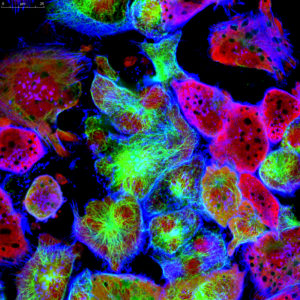
In recent years, scientists have been hot on the trail of transcription factor FOXO3, tracing its involvement in various tumor-centric activities comprising the many trademarks of cancer, from drug resistance to metastasis to tumor angiogenesis.
FOXO3 is a member of the O sub-class of the forkhead box family of transcription factors. The forkhead box (FOX) family is characterized by a fork head DNA-binding domain (DBD), comprised of around 100 amino acids. They have also proven themselves to be a family of many hats, functioning in diverse roles ranging from metabolism, immunology, cell-cycle control, development, as well as cancer (1). The forkhead box O (FOXO) sub-class alone has demonstrated involvement in a variety of cellular outcomes, from drug resistance and longevity to apoptosis induction.
Due to its pro-apoptotic and anti-proliferative proclivity, FOXO3 has been previously identified as a tumor suppressor gene. However, more and more studies have begun to flip the narrative on FOXO3, portraying it more as a devoted henchman, due to its roles in drug and radiotherapy resistance, cell-cycle arrest and long-term maintenance of leukemia-initiating stem cells in a variety of cancer types, including breast cancer, pancreatic cancer, glioblastoma, and both acute and chronic myeloid leukemia.
A team of scientists from the Medical University Innsbruck, Tyrolean Cancer Research Institute, and University of Innsbruck in Innsbruck, Austria have also determined that nuclear FOXO3 promotes chemoresistance in vitro (2) and tumor angiogenesis in vivo (3) in aggressive neuroblastoma (NB), a childhood tumor which develops from nerve cells in the fetus called neuroblasts and primarily affects children.
These findings implicate the inhibition of FOXO3 transcriptional activity as a promising therapeutic strategy for different types of cancer, including NB. In conjunction with a colleague from Paracelsus Medical University Salzburg in Salzburg Austria, another team of scientists from the aforementioned Austrian institutions have identified carbenoxolone disodium salt (CBX) as a promising candidate for the treatment of high-stage NB, among other cancers in a recent study.
The team began by screening the Prestwick Chemical Library®, comprised of 1120 FDA-approved drugs, and were able to pinpoint CBX as a potential FOXO3 inhibitor. CBX is a water-soluble disodium salt of glycrrhetinic acid hemisuccinate, and is currently used in the clinical treatment of inflammation and esophageal, oral and peptic ulceration. As CBX demonstrated potent effects on FOXO3 inhibition in the screening, it was selected to undergo additional testing to investigate its potential as a therapeutic strategy for NB as well as other cancers.
Through a variety of assays, the team was able to demonstrate that CBX interferes with the DBD-DNA binding of FOXO3, effectively silencing FOXO3 transcriptional activity. Utilizing the Luciferase Assay System to measure luciferase activity, they were able to determine that CBX treatment represses FOXO3-mediated activation of the DEPP-promoter (a direct transcriptional target gene of FOXO3 in NB cells) in a dose-dependent manner.
An increase in cellular apoptosis and elevated caspase-3/7 activity (measured using the Caspase-Glo® 3/7 Assay System) indicated that inhibiting FOXO3 by CBX significantly sensitized high-stage NB cells to treatment with the chemotherapy drugs etoposide and doxorubicin.
This chemo-sensitizing effect became even more apparent in a 3D cell culture model. In their microtissue culture, the team utilized the CellTiter-Glo® 3D Cell Viability Assay to quantify living cells following the treatment with either etoposide alone or in combination with CBX. They determined that the cell viability of these 3D spheroids, derived from high-stage NB8 cells, was considerably repressed when the etoposide was applied in conjunction with CBX.
Furthermore, they observed that FOXO3-knockdown cells only formed loose aggregates with smaller size, in comparision to the consistent shape and uniform size observed in 3D-cultivated NB8-shCtr spheroids, demonstrating that FOXO3 is imperative for formation of compact spheroids. It was also observed that FOXO3-knockdown put an end to drug resistance in the 3D spheroids that were derived from high-stage NB8 cells. One explanation for this effect is that FOXO3 activity is elevated in spheroids derived from neuronal tumor cells, which then initiates chemoresistance. As chemotherapy resistance is one of the greatest challenges facing NB treatment today, only bolsters
As if it wasn’t enough that the findings of this study emphasize the promise of CBX as an effective potential therapeutic treatment for cancer, the researchers also highlight that the protective effects of CBX-mediated FOXO3 inhibition could be of considerable interest in the study of neurodegenerative diseases. They note that FOXO3 has also been determined to play a critical role in promoting cell death in cases of cognitive impairment as well as in Alzheimer’s disease.
Other studies have also describe CBX improving cognitive function in type 2 diabetics and healthy elderly men, suppressing disease progression in mouse models of AD and amyotrophic lateral sclerosis, and also being neuroprotective during brain damage that follows intracerebral hemorrhage.
So, whether it will be in pursuit of therapeutic treatment of high-stage neuroblastoma, other FOXO-resistant cancers, or neurodegenerative diseases, CBX has certainly proven itself to be a worthy adversary of FOXO3 and an ever-promising starting point for future studies.
References:
- Tuteja, G. and Kaestner, K.H. (2007) Forkhead transcription factors II. Cell. 131(1): 1160.e1–1160.e2.
- Rupp, M. et al. (2017) FOXO3-mediated chemo-protection in high-stage neuroblastoma depends on wild-type TP53 and SESN3. Oncogene. 36: 6190–203.
- Hagenbuchner, J. et al. (2016) Nuclear FOXO3 predicts adverse clinical outcome and promotes tumor angiogenesis in neuroblastoma. Oncotarget. 7:77591–606.
